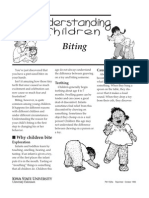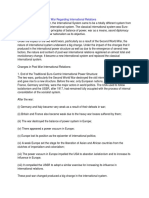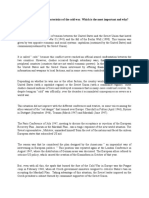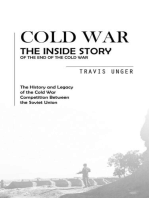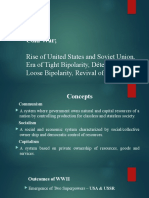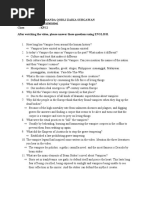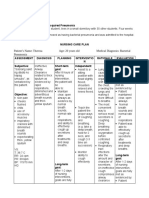Impact of World War II on Global Politics
Impact of World War II on Global Politics
Uploaded by
huzaifaamjad485Copyright:
Available Formats
Impact of World War II on Global Politics
Impact of World War II on Global Politics
Uploaded by
huzaifaamjad485Copyright
Available Formats
Share this document
Did you find this document useful?
Is this content inappropriate?
Copyright:
Available Formats
Impact of World War II on Global Politics
Impact of World War II on Global Politics
Uploaded by
huzaifaamjad485Copyright:
Available Formats
Impact of World War II on global
politics
After the Second World War, the International System came to be a
totally different system from the classical (19th century)
international system. The classical international system was Euro-
centric and it worked on the principles of balance of power, war as
a means, secret diplomacy as an instrument, and narrow
nationalism as its objective.
Under the impact of the two world wars, particularly as a result of
the Second World War, the nature of the international system
underwent a big change. Under the impact of the changes that it
produced in the international power structure as well as due to the
emergence of several new factors, the nature and content of post-
war international relations registered an almost total and
revolutionary change. It became a new international system and
replaced the classical international system.
Changes in Post War International Relations:
1. End of the Traditional Euro-Centric International Power
Structure:
The two wars, particularly the Second World War destroyed the old
international power structure and gave rise to a new structure.
Before the war, only European nations, particularly Britain, France,
Germany and Italy, were the major actors in world politics. The
USA used to follow isolationism and the USSR, after 1917, had
remained fully occupied with the process of internal consolidation
of the socialist system.
After the war:
(i) Germany and Italy became very weak as a result of their defeats
in war;
(ii) Britain and France also became weak due to the heavy war
losses suffered by them;
(iii) The war destroyed the balance of power system in Europe;
(iv) There appeared a power vacuum in Europe;
(v) Europe lost its position as the epicenter of international politics;
(vi) A weak Europe set the stage for the liberation of Asian and
African countries from the clutches of imperialism and colonialism;
(vii) The power vacuum in Europe impelled the USA to abandon
isolationism and to increase its influence in Europe.
(viii) It compelled the USSR to adopt a similar exercise for
increasing its influence in international relations.
These post-war changed produced a big change in the international
system.
2. Emergence of Cold War:
In the Post-war period, the USA decided to use its superior
economic and military position for filling the power vacuum in
Europe and for this end decided to win over the democratic
European nations through its Marshall Plan. It also adopted the
policy of fighting the spread of communism. ‘Containment of
Communism’ became the primary aim of US Foreign Policy.
Such an American attempt was thoroughly opposed by the Union of
Soviet Socialist Republic and it also decided to extend its influence
in Europe. The success that it achieved in exporting communism to
most of the East European countries emboldened it. The emergence
of China as a communist power in 1949 gave further strength to
the Soviet-led communist movement. The USSR adopted the policy
of challenging US policies. In the process, there developed a cold-
war—a war of nerves full of tensions and strains in world politics,
which made international peace a risky and unstable peace.
3. Emergence of Bipolarity—Bipolar Power Structure:
The emergence of the cold war led to the organization of two
competing and rival camps by both the USA and the USSR. The
USA floated a large number of bilateral and multilateral alliances
like NATO, SEATO, ANZUS, and several others for consolidating
the democratic anti-communist countries under its own leadership.
The USSR countered the move by organizing the communist
countries into the Warsaw Pact. These developments led to the
emergence of two rival camps—the US Bloc and the Soviet Bloc,
This situation came to be characterized as bipolarity in world
politics and it divided the world into two competing and even
hostile blocs.
4. Rise of Several New Sovereign States:
After World War II, the weakened position of the European imperial
powers and the strengthened spirit of national self- determination
and liberation among the colonies became instrumental in initiating
a process of end of colonialism and imperialism in the World. The
anti-imperial & anti-colonial movement began registering a
stupendous success.
Several nations of the world, particularly Asian and African nations,
were successful in overthrowing the yoke of colonialism and
imperialism and in securing their independence. There came to be
a big increase in the number of sovereign states in the world. The
rise of new sovereign states in Asia, and Africa and a resurgent
Latin America began giving a completely new look to the world map
and international relations.
5. Birth of Non-alignment:
In the era of the cold war and alliance politics, some states,
particularly some new states, decided to remain away from the cold
war and the superpower alliances. States like India, Yugoslavia,
Egypt, and Sri Lanka. Burma (now Myanmar) and some others
decided to follow such a policy. This comes to be known as the
policy of Non-alignment.
In 1960 the countries following non-alignment in international
relations launched the movement of the Non- aligned (NAM) for
collectively withstanding the pressures of the era of the cold war by
taking mutually accepted decisions and policies. The main aim of
Non-alignment and NAM was both to keep away from the cold war
and its alliances as well as to promote mutual understanding and
cooperation among the non-aligned states.
6. Democratization of Foreign Policy and Changes in
Diplomacy:
The end of the Second World War rejected the thesis of
authoritarianism in favor of democracy and under its influence, the
formulation and implementation of foreign policy became
democratic in nature and style. In the 19th century, the foreign
policy of a nation was formulated by a class of professional experts
—the diplomat and statesman.
It used to be a close preserve of the Foreign Office and Diplomacy.
The democratization of politics however made foreign policy an
object of discussion and subjected it to the influence of the common
man. National public opinion, press, and world public opinion came
to be important factors of foreign policy.
The changes in the nature, content, and working of foreign policies
of various nations resulted in a big change in the nature of post-war
international relations. Diplomacy also came out of its old style and
color and it now came to be new and open diplomacy.
7. Loss of Relevance of Balance of Power:
Between 1815-1914, Balance of Power acted as a regulator of
International relations. It suffered a big blow in the First World
War. It was revived in 1919, with a new mechanism like the League
of Nations, but it again flopped in 1939 when the Second World
War broke out.
After the end of the Second World War, several big structural
changes in the International system as well in the Balance of Power
system reduced the operation ability of this device. This rise of two
superpowers, the transformation of war into a total war, the
emergence of nuclear weapons, the establishment of the United
Nations, the emergence of the process of decline of imperialism-
colonialism, and several other such factors made the Balance of
Power system almost obsolete.
8. The Birth of Nuclear Age:
The final end of the Second World War came with the use of atomic
weapons by the USA against Japan. It symbolized the beginning of
the nuclear age in International Politics. For the first time, some
countries came to acquire means capable of destroying the entire
world. The nuclear factor divided the nations into nuclear nations
and non-nuclear nations, the former enjoying superiority in power
relations over the latter.
The two superpowers came to enjoy, as Max Lerner observed, the
capacity of “overkill”. Both, the U.S.A. and the U.S.S.R. could
destroy the entire world but no other nation individually or
collectively could destroy or defeat the superpowers. War became a
total war and the world found itself dependent on the policies and
activities of the two superpowers.
9. Transformation of War into Total War:
Nuclear weapons changed the nature of war from a Simple war to
total war. These made the war totally destructive. No nation
whether nuclear or non- nuclear, could hope to survive a future war
since it was bound to be a thermo-nuclear war.
10. Balance of Terror in place of Balance of Power:
The traditional concept of balance of power became obsolete in the
face of the fact that it became impossible to create a
preponderance of power against any aggressor backed by nuclear
power. The Balance of Power got replaced by a Balance of Terror
which made the international system very dangerous and risky. The
fear of mutually assured total destruction (MAD) through
accidental war began haunting the policy-makers of all the nations.
11. A New Desire for Peace:
The two World Wars within a short span and the possibility of a
much more destructive, rather totally destructive, Third World War
made humankind highly conscious of the need for preserving and
strengthening international peace and security. The urge for
securing peace became stronger than ever before.
12. Increasing Interdependence among Nations:
After the end of the Second World War, International relations
began developing a truly global character in which each nation
began finding its national interests inseparably bound up with the
interests of other nations as well as with international interests of
peace, security and development. This realization and the growing
interdependence of the world became instrumental in giving a vital
and welcome strength to the cause of peaceful and cooperative
international relations.
13. Birth of the UNO:
The failure of the League of Nations to maintain peace after the
First World War was mostly due to the shortcomings of the
Covenant of the League as well as because of the not fully
representative character of the League. Consequently, after the
Second World War, the statesmen felt no hesitation in agreement to
establish a new international organization—the United Nations
Organisation which came into existence on 24 October 1945.
The UNO was designed to act as an effective platform for
international diplomacy designed to secure international peace and
security, and development through collective efforts of all the
nations. The UN assumed the responsibility to maintain
international peace and security by promoting friendly cooperation
among the member states. Along with it, the UN Charter laid down
a collective security system as the new device of power
management in international relations.
14. Recognition of the Role of Power in International
Relations:
In the post-war period, the factor of power came to be accepted as
an incontrovertible fact of international relations. It was realized
that each nation is always prepared to use its national power to
secure the goals of her national interest. It was further realized
that the role of power in international relations was direct and the
nature of interactions among nations reflected a continuous
struggle for power. To analyze international politics as a struggle
for power or as a set of interactions involving power, came to be a
very popular approach in International Politics.
15. Emergence of the Age of Technology:
In the post-1945 years, man’s ability to use the knowledge of
scientific inventions for the welfare of humankind got greatly
enhanced. It was because of this fact that the 20th century came to
be known as the age of technology. Science and Technology began
playing a big role in changing the environment of international
relations.
As a result of the technological revolution, there began appearing a
revolutionary development in spheres of industry, transport,
communications, agriculture, and military. The resultant economic
growth became instrumental in producing big changes in the
nature of international relations.
The change in the concept of war from a simple war to a total war
gave a new dimension to international relations. The revolutionary
developments in the fields of transport and communication
increased the scope and frequency of relations among nations. The
rapid technological development in the developed countries made
them economically and militarily stronger enough to maintain a
neo-colonial control over the newly emerged developing countries.
Their monopoly over advanced technology and the disinclination to
share its benefits with all other nations produced sharp division
between nations—the developed and the under-developed or
developing nations. The relations between the developed and
under-developed later on became a focal issue of post-1945
international relations.
16. Emergence of a Peace Movement:
The two World Wars within a short duration and the possibility of a
much more destructive, rather totally destructive Third World War
made humankind highly conscious of the need for preserving and
strengthening international peace and security. The urge for
securing peace became stronger than ever before. There appeared
a welcome peace movement in international relations. This
encouraged nations to work for mutual welfare and development.
They became highly conscious of the need for development through
mutual cooperation and goodwill.
17. Rapidly Increasing Interdependence among Nations:
After the end of the Second World War, international relations
began developing a truly global character in which each nation
began finding its national interests inseparably bound up with the
interests of all other nations as well as with international interests
of peace, security, and development.
This realization and the interdependent nature of the international
community became instrumental in giving a vital and welcome
strength to the cause of peaceful and orderly international
relations. Peace became a cherished value and it gave a purpose to
international relations i.e. to find ways and means for securing and
strengthening stable and durable peace in the world. These gave an
encouraging and welcome direction to post-war international
relations.
18. End of the Traditional International System:
The international system of the post-war period became
totally different from the classical international system in
several ways:
(1) Power scarcity that characterized the classical international
system got replaced by power surplus (Nuclear weapons, overkill
capacity, and two superpowers) in the new system.
(2) The Balance of power got replaced by a Balance of Terror.
(3) The formulation and implementation of foreign policy became a
more complicated and democratic exercise.
(4) A big change in world political relations took place as a result of
the rise of new states, and the liquidation of imperialism and
colonialism.
(5) Peace, security, development, and prosperity for all the nations
got recognized as a value in international relations.
(6) There developed an arms race between the two superpowers
and the exercise became more dangerous because of the birth of
the nuclear arms race.
(7) Because of the increase in the number of states, there came to
be developed several new problems and international relations
became highly complex.
(8) The presence of the United Nations gave a new look to the post-
war international system.
(9) New and Open Diplomacy came to replace the old and secret
diplomacy.
(10) The presence of two competing, in fact, rival superpowers set
the stage for the emergence of the cold war and bi-polarity in
international relations.
(11) The transformation of war into a total war made it much more
dreaded and the nations became more and more interested in
preserving international peace and security.
(12) All the nations became conscious of the need for preserving
peace through a better and effective device of power management
i.e. collective security.
Thus the Second World War had a big impact on the nature of
international relations. The post-War International system came to
be a system totally different from the pre-war international system.
After the Second World War, the International System came to be a
totally different system from the classical (19th century)
international system. The classical international system was Euro-
centric and it worked on the principles of balance of power, war as
a means, secret diplomacy as an instrument, and narrow
nationalism as its objective.
It came to be replaced by a new international system which was
characterized by two superpowers, the cold war, bipolarity, non-
alignment, anti-imperialism, the UNO, the presence of several new
sovereign states in the world, N-weapons, and the threat of Total
War. This new international system continued to work, almost
unchanged, till the last decade of the 20th century when it came to
be a Post-Cold War, Unipolar International System experiencing a
new liberalization and globalization.
You might also like
- The Center A Modern Strategy Guide, Adrian Mikhalchisin and Georg MohrDocument254 pagesThe Center A Modern Strategy Guide, Adrian Mikhalchisin and Georg MohrAndrés Cabrera100% (15)
- International History 1900-99Document5 pagesInternational History 1900-99rizalmusthofa100% (1)
- Biting: Why Children BiteDocument4 pagesBiting: Why Children BitePamm100% (3)
- Fumihiko Maki Nurturing Dreams Collecte PDFDocument292 pagesFumihiko Maki Nurturing Dreams Collecte PDFchroma11No ratings yet
- Changes in Post 2nd World War Regarding International RelationsDocument7 pagesChanges in Post 2nd World War Regarding International RelationsArooj ZamanNo ratings yet
- Benazir Bhutto Shaheed University Lyari, Karachi, Sindh: International Relations After Second World WarDocument9 pagesBenazir Bhutto Shaheed University Lyari, Karachi, Sindh: International Relations After Second World Warganok balochNo ratings yet
- Impacts of Worldwar2 On Global Politics. Shahid AliDocument11 pagesImpacts of Worldwar2 On Global Politics. Shahid AliShahid AliNo ratings yet
- Imoact of WW2 On Global PoliticsDocument6 pagesImoact of WW2 On Global Politicsasmashah2004No ratings yet
- Adnan AkbarDocument33 pagesAdnan AkbarUmer HasanNo ratings yet
- The Cold WarDocument4 pagesThe Cold WarSohel AhmedNo ratings yet
- BinyameenDocument10 pagesBinyameenUmer HasanNo ratings yet
- THE COLD WAR-WPS OfficeDocument5 pagesTHE COLD WAR-WPS OfficeReynold N. AlbaNo ratings yet
- Cold WarDocument8 pagesCold Warjaverya15No ratings yet
- COLD WARDocument5 pagesCOLD WAReshafatima3536No ratings yet
- The End of WWII and the Start of the Cold WarDocument4 pagesThe End of WWII and the Start of the Cold Warheinemeyerh07No ratings yet
- US Second Semester Summary Second Year 1Document11 pagesUS Second Semester Summary Second Year 1Aymen LouetiNo ratings yet
- U.S. History Sem 2 Unit 3 Post War Years To The Cold WarDocument24 pagesU.S. History Sem 2 Unit 3 Post War Years To The Cold WarShahzad AfsarNo ratings yet
- Cold WarDocument5 pagesCold Warhussainfawad1313No ratings yet
- Foreign Policy of Major Powers: Communist BlocDocument4 pagesForeign Policy of Major Powers: Communist BlocQasim FarooqNo ratings yet
- EYHy FRC Lkgalqp 1 FDV OaDocument10 pagesEYHy FRC Lkgalqp 1 FDV Oabhairabimedhi295No ratings yet
- Origin of Cold WarDocument11 pagesOrigin of Cold WarchamberskmgNo ratings yet
- Impact of World War Two On Global Politics: January 2021Document27 pagesImpact of World War Two On Global Politics: January 2021leminhkhoi09112007No ratings yet
- Cold War in AfricaDocument17 pagesCold War in AfricaONAOLAPONo ratings yet
- IX. POST 1945 WORLD SCENARIO AND EMERGENCE OF USA AND USSR AS THE TWO WORLD POWERSDocument4 pagesIX. POST 1945 WORLD SCENARIO AND EMERGENCE OF USA AND USSR AS THE TWO WORLD POWERSsamiumar617No ratings yet
- World History OutlineDocument16 pagesWorld History OutlineFeng DuNo ratings yet
- 2-Cold WarDocument8 pages2-Cold WarJessica Cabanting OngNo ratings yet
- Unit 11 - The Cold WarDocument8 pagesUnit 11 - The Cold Wargs5zv7t2h7No ratings yet
- Western Mindanao State UniversityDocument6 pagesWestern Mindanao State UniversityRhea MarianoNo ratings yet
- Lecture9 IRDocument6 pagesLecture9 IRMustafa SherifNo ratings yet
- Cold War CharacteristicsDocument10 pagesCold War CharacteristicsDistro MusicNo ratings yet
- Paper-7Document98 pagesPaper-7Whang SiuNo ratings yet
- 'UMER's IR'Document16 pages'UMER's IR'Umer HasanNo ratings yet
- Confrontation, Cold WAR: Ir Since 1945Document18 pagesConfrontation, Cold WAR: Ir Since 1945Maheen AliNo ratings yet
- 3 Ad 82 Fdab 40 BF 68887 Da 48 F 104 AbebDocument10 pages3 Ad 82 Fdab 40 BF 68887 Da 48 F 104 AbebRahulMishraNo ratings yet
- The Cold War (1947-1991): A geopolitical tension between the United States and the Soviet UnionFrom EverandThe Cold War (1947-1991): A geopolitical tension between the United States and the Soviet UnionNo ratings yet
- Essential Question:: How Did World War II Change Europe and The World?Document25 pagesEssential Question:: How Did World War II Change Europe and The World?Valentina Maldonado PerezNo ratings yet
- Ecercise 10, PT 2Document9 pagesEcercise 10, PT 2Vanessasil24No ratings yet
- The Subject and The Tasks of The Discipline: ST STDocument4 pagesThe Subject and The Tasks of The Discipline: ST STCousins HasanovsNo ratings yet
- Cold War Notes For Class PRDocument3 pagesCold War Notes For Class PRnixeyo2616No ratings yet
- Term 1 Political ScienceDocument114 pagesTerm 1 Political ScienceHassan RazaNo ratings yet
- EFL ProjectDocument4 pagesEFL ProjectDaniel Arturo Mercado LópezNo ratings yet
- The Cold WarDocument3 pagesThe Cold WarReeta SinghNo ratings yet
- World War ConsequencesDocument5 pagesWorld War Consequencescoachwrites4No ratings yet
- Ali's AssignmentDocument4 pagesAli's Assignmentalfeelsaleh2023No ratings yet
- Cold War: The Inside Story of the End of the Cold War (The History and Legacy of the Cold War Competition Between the Soviet Union)From EverandCold War: The Inside Story of the End of the Cold War (The History and Legacy of the Cold War Competition Between the Soviet Union)No ratings yet
- PART-A Contemporary World Politics Cold WarDocument47 pagesPART-A Contemporary World Politics Cold WarjaywardhanbabaNo ratings yet
- Babar AtaaDocument11 pagesBabar AtaaUmer HasanNo ratings yet
- Untitled DocumentDocument2 pagesUntitled DocumentfigsinxNo ratings yet
- Project of Cold WarDocument13 pagesProject of Cold WarSyed renobaNo ratings yet
- 2.cold WarDocument43 pages2.cold WarahsanNo ratings yet
- The Need For An International OrderDocument7 pagesThe Need For An International OrderShrey GargNo ratings yet
- Cold WarDocument1 pageCold Waraldrinconstantino531No ratings yet
- Untitled document (5)Document5 pagesUntitled document (5)Ankit RoutNo ratings yet
- Describe The Different Phases of The Cold WarDocument9 pagesDescribe The Different Phases of The Cold WarSharonya RayNo ratings yet
- The Cold WarDocument12 pagesThe Cold WarBianca SamuelNo ratings yet
- Cold WarDocument43 pagesCold WarSherman UllahNo ratings yet
- Practices of The Spanish Civil WarDocument10 pagesPractices of The Spanish Civil Warmatilde.montoneriNo ratings yet
- More Critical Questions On Cold War CleanDocument4 pagesMore Critical Questions On Cold War CleanSuinNo ratings yet
- ANDREI ZHDANOV_Soviet Policy and world politicsDocument3 pagesANDREI ZHDANOV_Soviet Policy and world politicsAtienza, John Russell Bencalo BAPS 1-1No ratings yet
- Spectroscopia RamanDocument6 pagesSpectroscopia Ramandanaaaa007No ratings yet
- The Decline of Victorian ValuesDocument1 pageThe Decline of Victorian ValuesCarmen VillamainaNo ratings yet
- RBCW Programme Schedule June 2019Document5 pagesRBCW Programme Schedule June 2019bhargavNo ratings yet
- 2005 Seadoo 4 Tech Shop ManualDocument314 pages2005 Seadoo 4 Tech Shop Manualkatsika11100% (2)
- Design of Basketry Product-Week 3 4th QuaarterDocument29 pagesDesign of Basketry Product-Week 3 4th QuaarterLoraineTenorioNo ratings yet
- Digital Marketing Assignment PDFDocument23 pagesDigital Marketing Assignment PDFRaja Babu SharmaNo ratings yet
- C7-Islamic Trade Financing InstrumentsDocument5 pagesC7-Islamic Trade Financing Instrumentsnurainilmi2001No ratings yet
- Phil. Organic ActDocument15 pagesPhil. Organic Actka travelNo ratings yet
- Mandarain Orient Investment ThesisDocument15 pagesMandarain Orient Investment ThesisjwkNo ratings yet
- Class..9 (Chemistry Record)Document30 pagesClass..9 (Chemistry Record)SURYA FREE FIRENo ratings yet
- Basics of Latin Percussion PDFDocument3 pagesBasics of Latin Percussion PDFseregio12No ratings yet
- Name: Ramanda Qodli Zaika Surgawan Student Number: 204103010041 Class: Kpi 2 After Watching The Video, Please Answer These Questions Using ENGLISHDocument2 pagesName: Ramanda Qodli Zaika Surgawan Student Number: 204103010041 Class: Kpi 2 After Watching The Video, Please Answer These Questions Using ENGLISHRamanda zaikaNo ratings yet
- English Speaking Assessment Developing A Speaking Test For Students in A Preparatory School PDFDocument14 pagesEnglish Speaking Assessment Developing A Speaking Test For Students in A Preparatory School PDFLaksharoraNo ratings yet
- Download Complete The Human Past World Prehistory and the Development of Human Societies 3d edition Edition Chris Scarre PDF for All ChaptersDocument81 pagesDownload Complete The Human Past World Prehistory and the Development of Human Societies 3d edition Edition Chris Scarre PDF for All Chaptersdurulnebout100% (3)
- NCP For CAP TB.Document5 pagesNCP For CAP TB.Cherry Ann BalagotNo ratings yet
- Financial Analysis of Mozaffar Hossain Spinning Mills: Submitted byDocument12 pagesFinancial Analysis of Mozaffar Hossain Spinning Mills: Submitted byEhsanul AzimNo ratings yet
- Astronomy 1F03 NotesDocument32 pagesAstronomy 1F03 NotesDillen DochertyNo ratings yet
- Macmillan Education Student - Great Thinkers B1+ - Student's Book 4Document1 pageMacmillan Education Student - Great Thinkers B1+ - Student's Book 4Rodrigo PequeñoNo ratings yet
- 2011 Training Schedule VIDocument24 pages2011 Training Schedule VIHarold AlconzNo ratings yet
- BorrowingsDocument8 pagesBorrowingsDeepesh KatariyaNo ratings yet
- 37 Hernandez Vs CADocument14 pages37 Hernandez Vs CAJovy Norriete dela CruzNo ratings yet
- HCIA-WLAN V2.0 Experiment Guide (CLI-based) PDFDocument115 pagesHCIA-WLAN V2.0 Experiment Guide (CLI-based) PDFmrsanNo ratings yet
- 04 Hinduism Religion Study HinduDocument28 pages04 Hinduism Religion Study HinduJaoe Mae NavallascaNo ratings yet
- Wll-Ap7 - Q2 - Week 9Document3 pagesWll-Ap7 - Q2 - Week 9Camille Joyce AlegriaNo ratings yet
- Ariana Grande - Santa Tell Me ChordsDocument3 pagesAriana Grande - Santa Tell Me ChordsJuditCasasPerisNo ratings yet
- 2 5 1 Jazz Guitar Licks - G Minor - Wednesday Warm-Up - Tab & NotationDocument1 page2 5 1 Jazz Guitar Licks - G Minor - Wednesday Warm-Up - Tab & Notationpeterd87No ratings yet
- Sociocultural PerspectiveDocument11 pagesSociocultural PerspectiveadeshNo ratings yet


